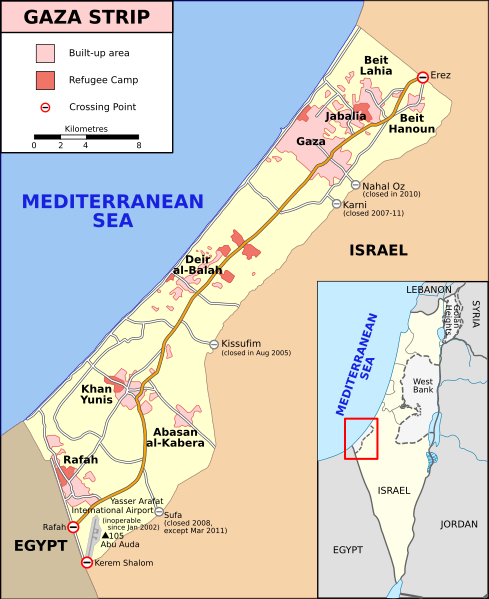After being caught off guard by Hamas, Israel, a Middle Eastern military powerhouse, initiated a robust counterattack. The Gaza Strip, under Hamas control, became the storm's focal point.
On October 9th, Israel announced a comprehensive blockade of the Gaza Strip, severing electricity, water, and fuel supplies. The Israeli Defense Forces proclaimed their intention to retake all towns near the Gaza border and intensify their airstrikes on the region.
As of now, the ongoing conflict has resulted in over 1,600 deaths, with thousands more injured. Israeli casualties have reached 900, while the West Bank and Gaza Strip have reported 704 and 687 deaths, respectively.
In preparation for their counteroffensive, Israel mobilized 300,000 reservists within 48 hours. The possibility of a ground invasion of Gaza by Israel has increased, and in response, Hamas has threatened to execute Israeli hostages.
A Closer Look at Gaza
The Gaza Strip is among the world's most densely populated areas. Over 2 million people reside in this 365-square-kilometer territory, with up to 1.7 million being Palestinian refugees. Due to Israel's prolonged blockade, Gaza is often dubbed an "open-air prison." Residents face severe restrictions on movement, coupled with dire economic and living conditions.
Should Israel launch a large-scale ground offensive in Gaza, civilian casualties would inevitably surge. UN data reveals that of Gaza's over 2 million inhabitants, nearly half are children.
Geographically, Gaza is a narrow strip, 41 kilometers in length and 6 to 12 kilometers wide, bordering the Mediterranean Sea, Israel, and Egypt.
Historically, Gaza was part of Palestine, once under the Ottoman Empire and later a British "mandate" after World War I. The British divided Palestine along the Jordan River: the east became modern-day Jordan, while the west, including present-day Israel, the West Bank, and the Gaza Strip, remained Palestine.
In 1947, the UN proposed a partition of Palestine into Jewish and Arab states. The Arab state, covering 44% of the total area, included Gaza and the West Bank. The Jewish state occupied the remaining 56%. Despite the Arab population being significantly larger, they received less land, and the territory allocated to the Jewish state was more fertile.
This resolution led to Israel's establishment but was met with strong opposition from Arab nations. In 1948, the First Arab-Israeli War broke out. During this conflict, Egyptian forces occupied the Gaza Strip, maintaining control until 1967.
In 1967, the Six-Day War occurred. Israel captured the Sinai Peninsula from Egypt, the Golan Heights from Syria, the West Bank, Jerusalem, and the Gaza Strip from Egypt.
Israel's control over Gaza lasted 38 years, during which they established 21 Jewish settlements. However, Palestinians continuously resisted Israeli rule, resulting in two major uprisings.
After the first uprising, Israel restricted movement from Gaza in 1991. In 1994, under the Oslo Accords, Israel began transferring some autonomy in Gaza to the Palestinian Authority.
Following the second uprising, Israeli Prime Minister Ariel Sharon proposed a "unilateral disengagement" plan in 2003. By 2005, Israeli soldiers and over 7,000 settlers had left Gaza, and all Jewish settlements were dismantled. Control of Gaza was handed over to the Palestinian Authority, led by the Palestine Liberation Organization (Fatah).
However, Israel retained control over Gaza's airspace and continued military operations in its territorial waters. Israel also began extending the separation barrier around Gaza.
In 2006, Hamas won a majority in the Palestinian legislative elections. A brief unity government with Fatah quickly collapsed, leading to a civil war. By June 2007, Hamas had taken control of Gaza, which remains under its control today, while Fatah governs the West Bank.
After Hamas's takeover, Israel designated Gaza as "enemy territory" and imposed a comprehensive blockade.
Israel and Egypt control Gaza's land crossings. Since 2007, Israel and Egypt have frequently closed these crossings, with only two remaining operational before the current conflict.
Gaza's economic and social conditions have continuously deteriorated. The region's economy and job-creating capabilities have been destroyed, preventing it from developing into a skilled and well-educated society.
The UN has repeatedly called on Israel to end the blockade of Gaza, warning that it punishes ordinary citizens. According to the UN Relief and Works Agency for Palestine Refugees, due to the prolonged blockade, 81.5% of Gaza's population lives in poverty, and 63% are food insecure, relying on international aid.






